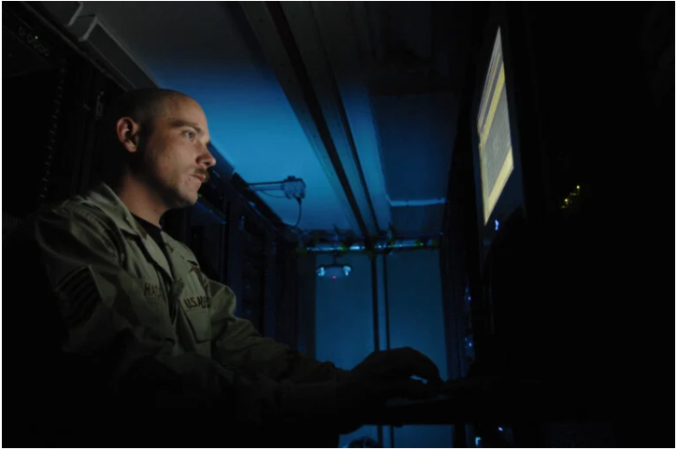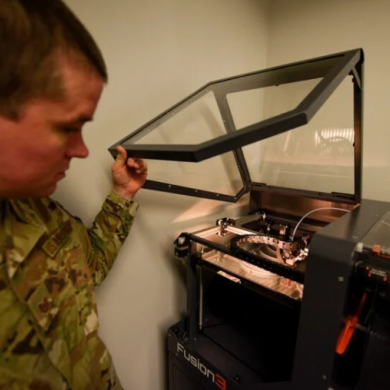16 avril 2021
Agility Prime Researches Electronic Parachute Powered by Machine Learning - Aviation Today
The Air Force's Agility Prime program awarded a phase I small business technology transfer (STTR) research contract to Jump Aero and Caltech.
21 juillet 2020 | International, Technologies propres, Méga données et intelligence artificielle, Fabrication avancée 4.0, Systèmes autonomes (Drones / E-VTOL), Conception et essais virtuels, Fabrication additive

By KELSEY ATHERTONon July 20, 2020 at 7:01 AM
ALBUQUERQUE: Venture capitalists want the Pentagon to be a good market. But for an industry that makes many unsuccessful bets in the promise that just a few pan out spectacularly, marketing software exclusively to the Pentagon poses an almost unacceptable risk. To ease startups into contracting, investors suggest the Army should provide unclassified, open-source data as the Air Force already does.
Near the top of his investors' wishlist, says Stu Solomon, CTO of intelligence provider Recorded Future, is removing “a lot of the friction necessary to get innovation into the government without having to be directly aligned or affiliated with the big solution integrators.”
Hitching new technology to a company already firmly ingrained in the Pentagon's ecosystem is a popular way to shepherd new software through the acquisitions process. It is also partly explains how, despite hundreds of millions of dollars in military contracts going to Silicon Valley companies, tech adoption seems as slow from the Valley as elsewhere.
Solomon's remarks came during a panel at AFCEA's 2020 AFCEA Army Signal conference. Recorded Future was founded in 2008, received early funding from IN-Q-TEL, received a contract from DIU in 2017, and a contract from Cyber Command in 2020. Much of Recorded Future's product is built on ingesting open-source information and offering analysis. As a feature, that meant the company could sustain itself in the commercial market, selling enterprise software, while still planning long-term to contract with the military, DHS, and intelligence services.
“If you think this is eventually going to be a market that matters to you, you're not going to be able to wait four years for the procurement process to mature as your product matures,” said Elizabeth Lawler, founder of Founder of AppLand.
If a startup's focus is solely on processing classified data, the capital investors need to be aligned directly with that goal to fund it since getting certified to handle classified material is one of the major sources of cost and friction.
“My current startup, focused on providing real-time up-to-date software images, works on things that are less sensitive as a starting point,” said Lawler, “for example, some of the code bases in the Air Force's open source code repository.”
Because open-source software lacks the same kind of cyber certification that comes with more sensitive information, it is fertile ground for start-ups looking to work on military data, provided the service makes an open-source library available.
“When it comes to this Valley of Death, I really view what we do when we start companies as an awful lot like a really difficult special forces mission,” said Andy Palmer, co-founder and CEO of data management company Tamr. “When you go in, you drop onto the ground to start a company, with a small team of people, and limited resources, and what oftentimes feels like an unreasonable objective. It's hand to hand combat for much of it, it's not pretty. The goal is survival.”
So, if the Army wants to bring new data tools to the battlefields of the future, it could start by creating open-source environments that allow companies to solve problems, at a smaller scale and without the hurdles of classification, suggested several panelists.
https://breakingdefense.com/2020/07/startups-need-free-data-to-work-with-army-venture-capitalists/

16 avril 2021
The Air Force's Agility Prime program awarded a phase I small business technology transfer (STTR) research contract to Jump Aero and Caltech.

19 mai 2020
"I've been so passionate about bringing in additive manufacturing, and small batch digital manufacturing, to help on aircraft parts availability," Air Force acquisition head Will Roper says. By THERESA HITCHENSon May 15, 2020 at 12:54 PM WASHINGTON: The Air and Space Forces are speeding efforts to adopt 3D printing as a major pillar of force sustainment, now making critical spare parts for weapon systems such as engine components for fighters and rockets. “Additive and advanced manufacturing [has] been going like gangbusters across the Air Force and Space Force — printing thousands of parts for airplanes,” Air Force acquisition head Will Roper said yesterday. “We're starting to print parts for satellites, including propulsion.” And today, the Air Force Rapid Sustainability Office (RSO) announced that it had reached a first milestone in its collaboration with General Electric to 3D print metal engine parts for aircraft — printing a metal sump pump for F-110 engines used by both F-15 and F-16 fighter jets. According to the announcement, the next phase of the program — Phase 1B , now being planned — will involve a family of parts on the TF34 engine, which has been in service for more than 40 years. “The collaborative effort between the US Air Force and GE shows great promise toward the adoption of metal 3D printed parts as an option to solve the US Air Force's current and future sustainment challenges,” Col. Benjamin Boehm, director of propulsion at the Air Force Life Cycle Management Center (AFLCMC) said in a press release. “This capability provides an alternate method to source parts for legacy propulsion systems throughout their life cycle, especially when faced with a diminishing supplier base or when infrequent demands or low volume orders are not attractive to traditional manufacturers.” GE originally approached the Air Force with the idea of a collaboration on 3D printed parts in 2019, and in April this year the service brought in the Defense Logistics Agency to help certify the GE-made parts for airworthiness. ALCMC, as we reported way back in September at the Air Force Association shindig, has also been pushing to get its depots around the country certified to print their own spare parts, beginning with those not critical to life and death. Air Force leaders see additive manufacturing as key to resolving the service's serious problems in maintaining aging aircraft and infrastructure and lowering costs. That said, the new 3D sump pump cover is an important piece of the engine. “Compared to other parts on the F110 engine, the sump cover might have lower functionality, but is incredibly important. It needs to be durable, form a seal and it needs to work for the entire engine to function – which is of course critical on a single engine aircraft like the F-16,” said James Bonar, engineering manager at GE Additive. The RSO-GE program is using a spiral development model, increasing the complexity and scale of parts printing with each phase. “In this program, complexity involves moving from simpler part identification, progressing to part and family of parts consolidation and eventually tackling complex components and systems, such as common core heat exchangers,” the press release said. Roper told reporters yesterday in a Zoom briefing that due to the COVID-19 pandemic, RSO has transformed its planned Advanced Manufacturing Olympics, originally planned to coincide with the now-postponed Tokyo Summer Olympics in late July, to a virtual event to be held November. It will allow 3D printing companies to show off their wares to potential service customers via a number of challenges, including a “printer shoot-off” and a “Box of Parts” challenge where manufacturers will compete to create a drone part without a blueprint. “We have been growing our network of small batch makers across the Air Force and Space Force,” Roper said. “I've been so passionate about bringing in additive manufacturing, and small batch digital manufacturing, to help on aircraft parts availability.” The COVID-19 crises has proven the “additive” value of tapping into a network of small manufacturers as the Air Force has scrambled to obtain personal protective equipment for airmen at far-flung bases, he explained. Because many large producers of items like face masks are overwhelmed, the service set up the “Air Force Rapid Advanced Manufacturing Portal,” or “AFRAMP,” as a method of finding and vetting small producers to meet service needs. “It's a portal where small batch manufacturers can make their capabilities known — show what they're able to produce — we vet them, and that then allows these small companies in aggregate to add up to large batch manufacturing,” Roper said. “We've already delivered over 11,000, different PPE devices to seven air bases that wouldn't have otherwise been able to get access for personal protective gear.” His hope is to expand that portal to other types of advanced manufacturing in the future. “I'm excited about scaling it up beyond just personal protective gear, and really having it be a one-stop-shop in the government for companies that can make things in small quantity — that can't mass produce, but can produce in mass if they're added up with a lot of their other sister companies.” https://breakingdefense.com/2020/05/air-forces-roper-3d-printing-going-like-gangbusters/

22 mai 2020
21st May 2020 - 10:21 GMT | by The Shephard News Team Booz Allen Hamilton will deliver AI-enabled products to the US Joint Artificial Intelligence Center (JAIC) under a $800 million contract from the GSA Federal Systems Integration and Management Center. If all options are exercised, work will be completed in May 2025. AI tools will support warfighting operations and be instrumental in embedding AI decision-making and analysis at all tiers of DoD operations. Booz Allen Hamilton will oversee a mix of technical services and products across the full spectrum of technical support to the JAIC Joint Warfighter National Mission Initiative. Work will include data labelling, data management, data conditioning, AI product development and the transition of AI products into new and existing fielded programmes and systems across the DoD. According to the DoD, the overall aim is to leverage the power of data to enable a ‘transformational shift across the DoD that will give the U.S. a definitive information advantage to prepare for future warfare operations'. https://www.shephardmedia.com/news/digital-battlespace/dod-selects-industry-partner-embed-ai-programmes-a/